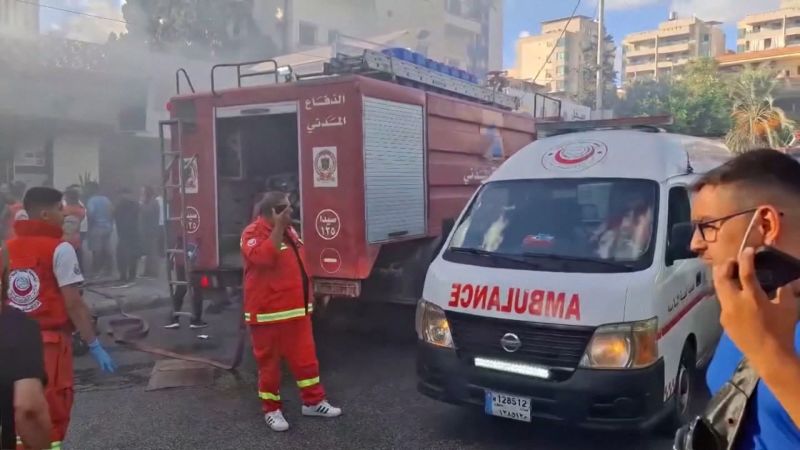
Middle East on the precipice again after Hezbollah leader vows retribution and Israel launches strikes. Here’s what we know
Israel launched one of its most intense bombardments against Hezbollah targets in Lebanon this year Thursday, hours after the militant group’s leader condemned deadly twin device attacks that he said crossed “all the red lines.”
Israel’s audacious, coordinated attacks, which targeted Hezbollah members with explosives hidden inside pagers and walkie-talkies, have once again brought the Middle East to the brink of a wider conflict nearly a year after Palestinian militant group Hamas’ October 7 assault on Israel that resulted in the ongoing war in Gaza.
Focus is now on what Hezbollah and Israel’s next moves will be, with the United Nations Security Council due to hold an emergency meeting Friday to discuss the situation.
Uncertainty remains over whether Israel’s attacks are a precursor to a ground invasion across its northern border into Lebanon and to what extent Iran-backed Hezbollah, one of the most powerful paramilitary forces in the region, is capable of responding even as its leader vowed that a “reckoning will come.”
Here’s what we know.
What’s the fallout?
At least 37 people were killed in the attacks Tuesday and Wednesday, including children, and nearly 3,000 injured. Hezbollah said at least 38 of its members have been killed since Tuesday afternoon, but didn’t provide further details.
In a speech Thursday, Hezbollah leader Hassan Nasrallah condemned the twin attacks, calling them “massacres” that “crossed all the red lines” because the devices exploded in public areas, with civilians among those harmed.
Though Hezbollah “suffered a major blow,” a “reckoning will come,” he added, and vowed the attacks would not bring the group down. The Hezbollah chief also warned Israel that fighting on the Lebanese front will not stop until hostilities end in Gaza.
What’s Israel’s plan?
As Nasrallah spoke Thursday, Israeli jets flew over Beirut, dropping flares and shaking windows with a wave of sonic booms that raised fears of an escalation in the Lebanese capital. Hours later, Israel launched a barrage of strikes in Lebanon, saying it hit about 100 Hezbollah rocket launchers and “terrorist infrastructure sites.”
Meanwhile, Hezbollah said it launched at least 17 attacks on military sites in northern Israel.
Israel has signaled its readiness for war with Hezbollah. The Israeli defense minister’s warning on Wednesday that a “new era” of war was beginning was followed by the military confirming its top commander had “completed approval of plans for the northern arena” along the Lebanon border.
The refocus north comes after Israel made it a new war objective to return diplaced residents to their homes near the northern border after being evacuated due to Hezbollah attacks.
How could Hezbollah respond?
Hezbollah leader Nasrallah hinted at retaliation for the twin attacks but it’s unclear what capacity the group might have to launch a counterattack if many of its members are wounded, and key communication methods are no longer reliable.
Despite Hezbollah appearing weakened, it is still believed to be the most heavily armed non-state group in the world with an increasingly sophisticated arsenal that has the potential to inflict significant damage on Israel.
There are however signs the already secretive group may have been driven deeper underground. The usual public gathering – typically consisting of high-level party officials and supporters – to watch Nasrallah’s speech was absent on Thursday.
And Nasrallah’s address – his first since the two waves of attacks – was possibly pre-recorded.
But the Hezbollah chief – who said the group’s leadership was mostly spared in the attacks as they were using older devices – has a powerful backer in Iran.
Lebanon-based Hezbollah is part of a Tehran-led axis spanning Yemen, Syria, Gaza and Iraq that has engaged in a simmering conflict with Israel and its allies over the past 11 months.
Iran’s Revolutionary Guard Corps Commander Hossein Salami reportedly told Nasrallah that Israel “will soon” face “a decisive and crushing response from (the) axis of resistance.”
The group also has a history of targeting Israel overseas, including a 1992 bomb attack at the Israeli embassy in Argentina that killed 29 people, and attacks on Israeli diplomats in India, Georgia and Thailand in 2012 that Israel blamed on Iran and Hezbollah, though the group denied involvement at the time.
Haven’t we been here before?
Fears that Israel’s devastating war in Gaza could spill into a wider regional conflict have flared to varying degrees of alarm since Hamas launched its deadly October 7 killing and kidnapping rampage.
Key players have at times appeared to walk right up to the brink, but tensions have de-escalated given the grave consequences of an all-out war in the Middle East.
But almost every week brings another violent incident that sets the region on high alert once again, with fears that an all out war would drag in the entire region, as well as Israel’s chief ally the United States.
In August, Iran pledged retaliation against Israel for the killing of Hamas political leader Ismail Haniyeh in Tehran, which came a day after a Hezbollah commander was killed in an Israeli airstrike in Beirut.
For months, the international community has been trying to de-escalate tensions between Israel and Hezbollah. That will continue Friday with the UN Security Council’s emergency meeting.
While Hezbollah’s leader has previously stated he does not want a fully-fledged regional war, experts have said he may now be under more pressure to act following the spate of explosions, and with Israel set on moving its military objectives to its northern border.
